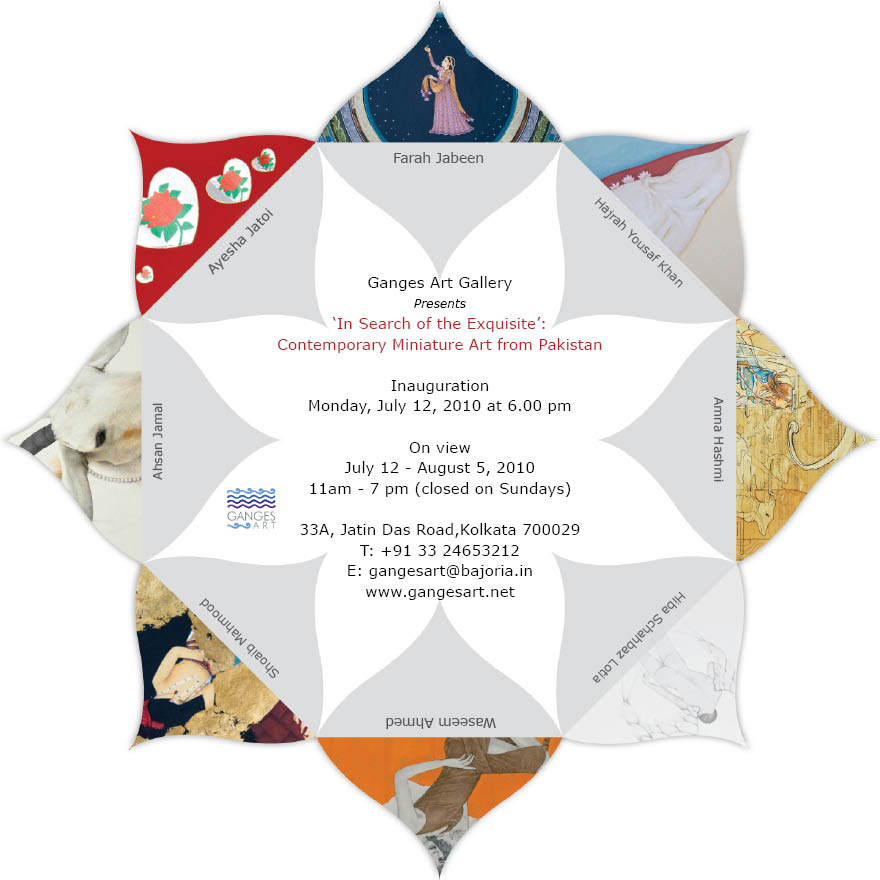
‘In Search of the Exquisite’: Contemporary Miniature Art from Pakistan
The miniature art of the subcontinent has a long and distinguished history. ‘In Search of the Exquisite’: Contemporary Miniature Art from Pakistan brings together a group of artists who, though schooled in this tradition have contemporized it. These artists combine a unique accuracy of observation with incredible technical precision. They have a deep and intuitive understanding of the special advantages of this sensitive format for capturing the feel of a particular place or moment and appreciate the inner vibrancy of the subcontinent’s cultural heritage and convey its indescribable mystery and romance through sensitive forms and tones. All temptation towards grandeur and obvious drama are avoided. Instead, they develop intimacy and atmosphere and the works are, therefore, pregnant with mystery, wistfulness and nostalgia.
In these works there is none of the problematic confusion between tradition and the avant-grade which characterizes the works of so many contemporary artists from the subcontinent. Instead, they reinvent the glorious tradition of the miniature and, in doing so, re-evaluate it such that it is no longer opposed to modernity. This aim is clearly not a conscious one. Instead, the boundaries become blurred simply through their engagement with the format and through the act of creation. To many this appears to be indulging an anachronistic practice: labour intensive and limited in the scope of its impact. These artists, however, treat it as a practice whose present is of the past and engagement with it a valid, indeed necessary, act. The artists, though, are interested in the form’s cultural and historical dimensions, not simply as they relate to visual and aesthetic pleasure but at a more fundamental level.
In these superb depictions, the artists use a large and varied visual vocabulary: part traditional, part modern, part reinvented and part unabashedly harkening back to earlier forms. They, therefore, find as great a freedom in the past as they do in the present. There are, of course, numerous ways of using the miniature format within which multiple visual discourses have existed simultaneously. It is anything but fixed and leaves a vast amount of room for experimentation. They have not been restricted by the more hidebound aspects of the tradition, though, in particular its self-referentiality and the lack of a context outside itself.
The artists use myriad points of reference and are able to coherently handle the simultaneous existence of a variety of visual materials. When drawing on multiple references, some from within a tradition, others from lived experience, it becomes as question of balancing the cultural and the personal. They can successfully mix recognizable cultural references with idiosyncratic ones and are, thus, able to fashion a vocabulary that, while referencing and maintaining tradition, also show their own experiences which are then subjected to detailing and definition: accessorizing, ornamentalizing and decorating.
All these artists are acutely aware that miniature painting comes with a set of rules. It is not at a conceptual level that those rules are played out. It is in the act, in the materiality, the seductiveness of the surface, the submission and the hours that are put in to create a sense of the sublime. To this end, miniatures are very meditative and meaningful gestures, much like rituals and more about subverting modernity than subverting tradition in the sense that they are spontaneous and gestural. They are open and democratic with a sense of rigour rather then being fussy or fetishistic. These works are about the process of image making and, thus, akin to artistic journals or dairies. It is, however, never a decision to go create an image with the goal of unearthing a set of experiences. There are, in fact, moments when a slower, more controlled pace sets in and the image unravels itself as a series of steps. Step one sometimes leads to step ten: the structure, the build up of materials, the hours of finishing. In the end, though, there is always the risk that the piece could be lost. There are moments when one looks at a miniature and wonders: what made them do it so obsessively? The artists are clearly not interested in living up to past standards of excellence in miniature painting. Instead, it is the simultaneous existence of two forms of exploration within a single space that they are interested in which, consequently, infuses the work with its transcendental qualities.
There are, naturally, many threads that inform this practice. To some, they may appear exotic, even orientalist. Viewers tend to see these works as elaborate codes that will reveal a cultural or political agenda. This is simply not the case. The imagery used is exotic, but shorn of provocation. The works are, fundamentally, about observation. Without a context, there is a school of thought which argues that art such as this is merely about technique which needs to be held up by the conceptual crutch of ‘post-colonial discourse’. This is more about the inability to see ‘the conceptual’ in forms outside the recent, narrow parameters established by the practices of the 1960s than anything else. Miniature painting is a profoundly ‘conceptual’ activity in which every little mark is important where meaning is constructed not simply within the piece but also through a larger set of relationships that surround the work. It is about fluidity, about imagery existing in different combinations. If these works are about anything, they are about accumulated experiences and how to understand and claim those experiences.